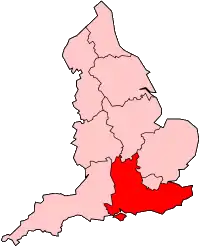Rampion Wind Farm
Rampion is an offshore wind farm development by E.ON, off the Sussex coast in the UK. The wind farm has a capacity of 400 MW (originally 700 MW was planned).[4] The wind farm was commissioned in April 2018.[2]
| Rampion Offshore Wind Farm | |
|---|---|
 | |

| |
| Country | England, United Kingdom |
| Location | English Channel, off the coast of Sussex |
| Coordinates | 50°40′0″N 0°16′0″W |
| Status | Operational |
| Commission date | 2018 [1][2] |
| Construction cost | £1.3 billion |
| Owner(s) | RWE (30.1%) E.ON (20%) UK Green Investment Bank (25%) Enbridge (24.9%)[3] |
| Operator(s) | E.ON |
| Wind farm | |
| Type | Offshore |
| Distance from shore | 13 km (8.1 mi) |
| Site area | 72 km2 (27.8 sq mi) |
| Power generation | |
| Units operational | 116 |
| Make and model | MHI Vestas V112-3.45MW |
| Nameplate capacity | 400 MW |
| External links | |
| Website | Rampion Offshore Wind Farm |
| Commons | Related media on Commons |
Location
Located between 13 and 25 kilometres (8 and 16 mi) from the shore, the wind farm is situated off the coast of the towns of Worthing and Shoreham-by-Sea to the west, the city of Brighton and Hove in the centre and the towns of Newhaven and Seaford in the east. The wind farm lies in a zone that is an irregular elongated area, approximately 28 kilometres (17 mi) in an east to west direction and approximately 10 kilometres (6.2 mi) in the north to south direction, an area of 72 square kilometres (27.8 sq mi).[4][5]
Name

Initially known as Zone 6 off the Sussex coast,[6] it was later named the "Southern Array" (Hastings).
When the site of the wind farm was changed from near Hastings to off Brighton, E.ON held a competition with local schools to suggest a new name as a public relations exercise. The name ‘Rampion’ was voted the winning suggestion, submitted by Davison C of E High School Pupil Megan McCullough, after the round-headed rampion (Phyteuma orbiculare), also known as the Pride of Sussex,[7] the county flower of Sussex.[6]
Planning
E.ON's final plans use 116 turbines of approximately 3.45 MW capacity, each 140 metres (459.3 ft) high to the tip of the blade, blade length is 55m, and radius is 12m[4] which represents a 43% reduction in the size of the development after planning consent was granted.[8]
E.ON originally proposed using either 175 smaller turbines of 3–3.6 MW capacity, each 180 metres (590.6 ft) above low tide sea level, or 100 larger turbines of 7 MW capacity, each 210 metres (689.0 ft) above sea level.[6] Development and construction costs were estimated at £2 billion.[6] As the turbines are designed to last approximately 20–25 years,[6] and since E.ON's lease of the site from the Crown Estate is for 50 years, the company would eventually need to replace the turbines.[6]
After an 18 month evaluation process between Newhaven and Shoreham ports, E.ON chose Newhaven as their base for Operations and Maintenance facility. The company took a lease on a site at the Port of Newhaven, where they constructed two new buildings to house the administration and engineering functions of the wind farm. The site and associated buildings will act as the combined servicing point for the wind farm.[9]
The project was approved by the government in July 2014.[10] In November 2014, E.ON announced that it had reduced the proposed capacity of the project by approximately 40%.[4] Onshore construction work began in June 2015 with construction of a new electricity substation adjacent to the existing National Grid Bolney 400/132kV substation[6] near Twineham.[11] Off shore the 116 monopile foundations were piled into the sea bed and on completion of this the first wind turbine was lifted into place in March 2017. Coincident with this was the ongoing work to backfill the cable duct trenches off Lancing beach initially due to be completed in Spring 2017.[12] Installation of the remainder of the 150kV cable through to Bolney and the burying in the sea bed of the 33kV inter array cables was also completed during this time following the installation of a 2,000 tonne offshore 33/150kV substation that was completed in April 2017.[13] An excavator was stranded and disabled after completing cable trench backfilling work in April 2017;[14][15] it was removed in June 2017.[16] Electricity production commenced during November 2017.[17] Construction of the wind farm was completed in 2018 at a cost of £1.3 billion.[11][2]
References
- "First turbine installed at Rampion" (PDF). E.ON. Retrieved 15 May 2017.
- "Rampion Offshore Wind Farm Hits Full Stride". Offshore Wind. Retrieved 2018-05-03.
- "Owners Rampion Offshore Wind". Retrieved 2020-10-15.
- "E.ON announces final 116 turbine design for Rampion Offshore Wind Farm". E.ON. Retrieved 16 December 2014.
- "Rampion - 116 turbines to be built". 4C Offshore. Retrieved 23 April 2018.
- "Rampion Offshore Wind Farm Frequently Asked Questions (FAQs), February 2012" (PDF). E.ON. Archived from the original (PDF) on 31 May 2012. Retrieved 30 March 2012.
- "Five Fascinating Facts about . . . Ditchling Beacon". Sussex Wildlife Trust. Retrieved 1 February 2013.
- "E.on cuts Rampion by 43%". WPO Intelligence. Retrieved 14 November 2016.
- "Newhaven Port reveals how the Rampion wind farm will help secure its future". Sussex Express. 12 October 2012. Retrieved 10 February 2013.
- "Rampion offshore wind farm approved by government". BBC News. 16 July 2014. Retrieved 22 July 2014.
- "Rampion wind farm construction gets under way". BBC News. 18 May 2015.
- "First giant turbines installed at wind farm". The Argus. Retrieved 2017-03-11.
- "2,000-tonne substation is installed at Rampion wind farm". www.worthingherald.co.uk.
- "Lancing Beach wind farm excavator stranded at sea". April 11, 2017 – via www.bbc.co.uk.
- https://www.eonenergy.com/About-eon/our-company/generation/planning-for-the-future/wind/offshore/~/media/Content%20Editors/ECR/Rampion/Newsletters/1707%20Rampion%20Newsletter%20Summer%202017%20Final.pdf
- "Moby Dig: £850,000 digger stuck in the sea finally removed". The Argus.
- "Milestone as Rampion generates first power". The Argus. Newsquest. Retrieved 23 April 2018.
